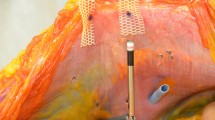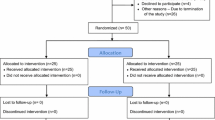Abstract
Purpose
Ventral hernia repair can be performed safely using meshes which are primarily stable upon dynamic intermittent straining (DIS) at recommended overlap. In specific clinical situations, e.g., at bony edges, bridging of the hernial orifice with reduced overlap might be necessary. To gain insight into the durability of various applications, two different meshes with the best tissue grip known so far were assessed.
Methods
The model uses dynamic intermittent strain and comprises the repetition of submaximal impacts delivered via a hydraulically driven plastic containment. Pig tissue simulates a ventral hernia with a standardized 5 cm defect. Commercially available meshes classified as primarily stable at recommended overlap were used to bridge this defect at recommended and reduced overlap.
Results
Using Parietex Progrip®, the peritoneum adds sufficient stability at least to a 2.5 cm overlap. Using Dynamesh Cicat®, four gluing spots with Glubran® are sufficient to stabilize a 3.75 cm overlap. A 2.5 cm overlap is stabilized with eight bonding spots Glubran® and 8 bonding spots combined with four sutures stabilize a 1.25 cm overlap. Here again, an intact peritoneum stabilizes the reconstruction significantly.
Conclusions
Based on a pig tissue model, a total of 23 different conditions were tested. A DIS class A mesh can be easily stabilized bridging a 5 cm hernial orifice with reduced overlap. Caution must be exerted to extend these results to other DIS classes and larger hernial orifices. Further DIS investigations can improve the durability of hernia repair.







Similar content being viewed by others
References
Albino FP, Patel KM, Nahabedian MY, Sosin M, Attinger CE, Bhanot P (2013) Does mesh location matter in abdominal wall reconstruction? A systematic review of the literature and a summary of recommendations. Plast Reconstr Surg 132:1295–1304
den Hartog D, Dur AHM, Tuinebreijer WE, Kreis RW (2008) Open surgical procedures for incisional hernias. Cochrane Database Syst Rev 3. Art. No.: CD006438. doi:10.1002/14651858.CD006438.pub2
Nguyen MT, Berger RL, Hicks SC, Davila JA, Li LT, Kao LS et al (2014) Comparison of outcomes of synthetic mesh vs suture repair of elective primary ventral herniorrhaphy: a systematic review and meta-analysis. JAMA Surg 149:415–421
Köckerling F, Schug-Paß C, Adolf D, Reinpold W, Stechemesser B (2015) Is pooled data analysis of ventral and incisional hernia repair acceptable? Front Surg 2:15. doi:10.3389/fsurg.2015.00015
Lyons M, Mohan H, Winter DC, Simms CK (2015) Biomechanical abdominal wall model applied to hernia repair. Br J Surg 102:e133–e139
Sahoo S, DeLouier KR, Erdemir A, Derwin KA (2015) Clinically relevant mechanical testing of hernia graft constructs. J Mech Behav Biomed Mater 41:177–188
Turner RD, Bothamley GH (2014) How to count coughs? Counting by ear, the effect of visual data and the evaluation of an automated cough monitor. Respir Med 108:1808–1815
Werner JG, Castellon-Larios K, Thongrong C, Knudsen BE, Lowery DS, Antor MA, Bergese SD (2015) Desflurane allows for a faster emergence when compared to sevoflurane without affecting the baseline cognitive recovery time. Front Med 2:75–80
An LJ, Gui B, Su Z, Zhang Y, Liu HL (2015) Magnesium sulfate inhibits sufentanil-induced cough during anesthetic induction. Int J Clin Exp Med 8:13864–13868
Siassi M, Mahn A, Vollmer M, Huber G, Morlock M, Kallinowski F (2014) Development of a dynamic model for ventral hernia mesh repair. Langenbecks Arch Surg 399:857–862
Kallinowski F, Baumann E, Harder F, Siassi M, Mahn A, Vollmer M, Morlock MM (2015) Dynamic intermittent strain can rapidly impair ventral hernia repair. Biomech J 48:4026–4036. doi:10.1016/j.jbiomech.2015.09.045i
Müllen A, Obolenski B, Schneemelcher S (2010) Textile net implant for supplying incisional hernia during open or laparoscopic surgical intervention to e.g. close hernial opening, has overlay pattern comprising pattern elements movably arranged parallel to each other. DE 102010023413 A1
Binnebösel M, Rosch R, Junge K, Flanagan TC, Schwab R, Schumpelick V et al (2007) Biomechanical analyses of overlap and mesh dislocation in an incisional hernia model in vitro. Surgery 142:365–371
Guerin G, Turquier F (2013) Impact of the defect size, the mesh overlap and the fixation depth on ventral hernia repairs: a combined experimental and numerical approach. Hernia 17:647–655
Podwojewski F, Otténio M, Beillas P, Guerin G, Turquieer F, Mitton D (2013) Mechanical response of animal abdominal walls in vitro: evaluation of the influence of a hernia defect and a repair with a mesh implanted intraperitoneally. J Biomech 46:561–566
Podwojewski F, Otténio M, Beillas P, Guerin G, Turquieer F, Mitton D (2014) Mechanical response of human abdominal walls ex vivo: effect of an incisional hernia and a mesh repair. J Mech Behav Biomed Mater 38:126–133
Rieder E, Stoiber M, Scheikl V, Poglitsch M, DalBorgo A, Prager G, Schima H (2011) Mesh fixation in laparoscopic incisional hernia repair: glue fixation provides attachment strength similar to absorbable tacks but differs substantially in different meshes. J Am Coll Surg 212:80–86
Muysoms F, Vander Mijnsbrugge G, Pletinckx P, Boldo E, Jacobs I, Michiels M, Ceulemans R (2013) Randomized clinical trial of mesh fixation with “double crown” versus “sutures and tackers” in laparoscopic ventral hernia repair. Hernia 17:603–612
Harslof SS, Wara P, Friis-Andersen H (2014) Fixation devices in laparoscopic ventral hernia repair: a review. Surg Technol Int 24:203–213
Christoffersen MW, Brandt E, Helgstrand F, Westen M, Rosenberg J, Kehlet H, Standfelt P, Bisgaard T (2015) Recurrence rate after absorbable tack fixation of mesh in laparoscopic incisional hernia repair. Br J Surg 102:541–547
Malik A, Macdonald AD, de Beaux AC, Tulloh BR (2014) The peritoneal flap hernioplasty for repair of large ventral and incisional hernias. Hernia 18:39–45
Tse G, Stutchfield BM, Duckworth AD, de Beaux AC, Tulloh B (2010) Pseudo-recurrence following laparoscopic ventral and incisional hernia repair. Hernia 14:583–587
Oguz H, Karaqule E, Turk E, Moray G (2015) Comparison of peritoneal closure techniques in laparoscopic preperitoneal inguinal hernia repair: a prospective randomized study. Hernia 19:879–885
Van’t Riet M, Van Steenwijk PJ, Kleinrensink GJ, Steyerberg EW, Bonjer HJ (2002) Tensile strength of mesh fixation methods in laparoscopic incisional hernia repair. Surg Endosc 16:1713–1716
Sorour MA (2014) Interposition of the omentum and/or the peritoneum in the emergency repair of large ventral hernias with polypropylene mesh. Int J Surg 12:578–586
Christoudias G, Nunziata M (2015) A simplified laparoscopic approach to ventral hernia repair: a new “finned” mesh configuration with defect closure. Surg Endosc. doi:10.1007/s00464-015-4480-7 [Epub ahead of print]
Acknowledgements
The project was funded by the institutional support of ASKLEPIOS Proresearch project number 2805, clinical research and development, Lohmühlenstraße 5, 20099 Hamburg, Germany. Further institutional support was granted by Heidelberger Stiftung Chirurgie, project number D.10052599, Chirurgische Universitätsklinik Heidelberg, Im Neuenheimer Feld 110, 69120 Heidelberg, Germany. In addition, financial support was supplied by Covidien contracted as project number SS3438 with ASKLEPIOS Proresearch. Materials were supplied in part by Dahlhausen and Covidien. We thank Angela Assing for supporting the data acquisition. We thank Mia Stine Matzkow for review of the language used.
Author information
Authors and Affiliations
Corresponding author
Ethics declarations
Conflict of interest
FK reports grants from Covidien and non-financial support from Dahlhausen, during the conduct of the study. AM reports grants from Covidien and non-financial support from Dahlhausen during the conduct of the study. FK and AM declare conflicts of interest not directly related to the submitted work. FH, TGS, MV declare no conflict of interests
Ethical approval
All applicable international, national, and/ or institutional guidelines for the care and use of animals were followed.
Statement of human and animal rights
I hereby undersign and certificate that the procedures and the experiments I have conducted respect the ethical standards in the Helsinki Declaration of 1975, as revised in 2000, as well as the national law. Experiments with laboratory animals were not conducted.
Informed consent
Informed consent was obtained from all individual participants included in the study.
Rights and permissions
About this article
Cite this article
Kallinowski, F., Harder, F., Silva, T.G. et al. Bridging with reduced overlap: fixation and peritoneal grip can prevent slippage of DIS class A meshes. Hernia 21, 455–467 (2017). https://doi.org/10.1007/s10029-017-1583-1
Received:
Accepted:
Published:
Issue Date:
DOI: https://doi.org/10.1007/s10029-017-1583-1




